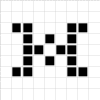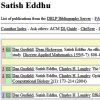  
Dan Gusfield,
Dean Hickerson and
Satish Eddhu. An efficiently computed lower bound on the number of recombinations in phylogenetic networks: Theory and empirical study. In DAM, Vol. 155(6-7):806-830, 2007.
Note: http://wwwcsif.cs.ucdavis.edu/~gusfield/cclowerbound.pdf.
Toggle abstract
"Phylogenetic networks are models of sequence evolution that go beyond trees, allowing biological operations that are not tree-like. One of the most important biological operations is recombination between two sequences. An established problem [J. Hein, Reconstructing evolution of sequences subject to recombination using parsimony, Math. Biosci. 98 (1990) 185-200; J. Hein, A heuristic method to reconstruct the history of sequences subject to recombination, J. Molecular Evoluation 36 (1993) 396-405; Y. Song, J. Hein, Parsimonious reconstruction of sequence evolution and haplotype blocks: finding the minimum number of recombination events, in: Proceedings of 2003 Workshop on Algorithms in Bioinformatics, Berlin, Germany, 2003, Lecture Notes in Computer Science, Springer, Berlin; Y. Song, J. Hein, On the minimum number of recombination events in the evolutionary history of DNA sequences, J. Math. Biol. 48 (2003) 160-186; L. Wang, K. Zhang, L. Zhang, Perfect phylogenetic networks with recombination, J. Comput. Biol. 8 (2001) 69-78; S.R. Myers, R.C. Griffiths, Bounds on the minimum number of recombination events in a sample history, Genetics 163 (2003) 375-394; V. Bafna, V. Bansal, Improved recombination lower bounds for haplotype data, in: Proceedings of RECOMB, 2005; Y. Song, Y. Wu, D. Gusfield, Efficient computation of close lower and upper bounds on the minimum number of needed recombinations in the evolution of biological sequences, Bioinformatics 21 (2005) i413-i422. Bioinformatics (Suppl. 1), Proceedings of ISMB, 2005, D. Gusfield, S. Eddhu, C. Langley, Optimal, efficient reconstruction of phylogenetic networks with constrained recombination, J. Bioinform. Comput. Biol. 2(1) (2004) 173-213; D. Gusfield, Optimal, efficient reconstruction of root-unknown phylogenetic networks with constrained and structured recombination, J. Comput. Systems Sci. 70 (2005) 381-398] is to find a phylogenetic network that derives an input set of sequences, minimizing the number of recombinations used. No efficient, general algorithm is known for this problem. Several papers consider the problem of computing a lower bound on the number of recombinations needed. In this paper we establish a new, efficiently computed lower bound. This result is useful in methods to estimate the number of needed recombinations, and also to prove the optimality of algorithms for constructing phylogenetic networks under certain conditions [D. Gusfield, S. Eddhu, C. Langley, Optimal, efficient reconstruction of phylogenetic networks with constrained recombination, J. Bioinform. Comput. Biol. 2(1) (2004) 173-213; D. Gusfield, Optimal, efficient reconstruction of root-unknown phylogenetic networks with constrained and structured recombination, J. Comput. Systems Sci. 70 (2005) 381-398; D. Gusfield, Optimal, efficient reconstruction of root-unknown phylogenetic networks with constrained recombination, Technical Report, Department of Computer Science, University of California, Davis, CA, 2004]. The lower bound is based on a structural, combinatorial insight, using only the site conflicts and incompatibilities, and hence it is fundamental and applicable to many biological phenomena other than recombination, for example, when gene conversions or recurrent or back mutations or cross-species hybridizations cause the phylogenetic history to deviate from a tree structure. In addition to establishing the bound, we examine its use in more complex lower bound methods, and compare the bounds obtained to those obtained by other established lower bound methods. © 2006 Elsevier B.V. All rights reserved."
@Article{GHE2007,
AUTHOR = {Gusfield, Dan and Hickerson, Dean and Eddhu, Satish},
TITLE = {An efficiently computed lower bound on the number of recombinations in phylogenetic networks: Theory and empirical study},
YEAR = {2007},
JOURNAL = {DAM},
VOLUME = {155},
NUMBER = {6-7},
PAGES = {806-830},
URL = {http://dx.doi.org/10.1016/j.dam.2005.05.044},
NOTE = { http://wwwcsif.cs.ucdavis.edu/~gusfield/cclowerbound.pdf},
ANNOTE = {BIBUPDATE : 20070914} } |